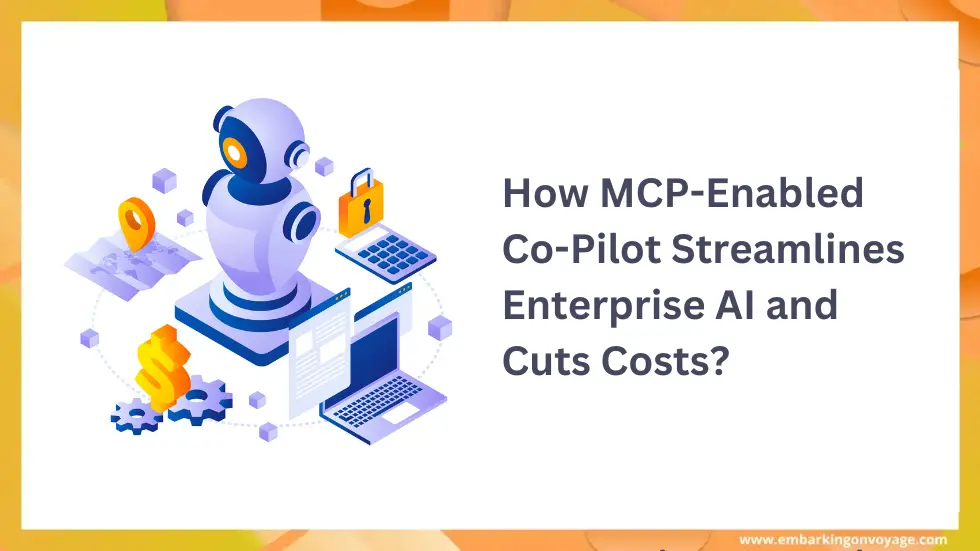In today’s competitive enterprise landscape, AI assistants are evolving beyond simple task automation—they are becoming strategic business enablers. Imagine a “Co-Pilot” that not only understands instructions but also executes them across CRM, ERP, DevOps, and other critical enterprise systems. With MCP-enabled Co-Pilot, this vision is now achievable.
What Is MCP in Business Terms?
The Model Context Protocol (MCP) functions like a universal connector—similar to how USB-C standardizes hardware connections, MCP standardizes AI integration with enterprise systems.
It allows AI assistants like Co-Pilot to discover, invoke, and interact with business services without requiring custom-coded integrations.
From retrieving sales reports to updating support tickets or automating workflows, MCP-enabled Co-Pilot ensures smooth, reliable interaction between AI and enterprise tools, boosting productivity and operational efficiency.
Why MCP-Enabled Co-Pilot Is a Strategic Advantage
Faster Delivery with Minimal Coding
Integration no longer requires weeks of custom development. MCP-enabled Co-Pilot plugs into MCP servers, acting as universal interfaces. This reduces integration timelines from weeks to just days.
Future-Ready and Maintainable
Adding or updating enterprise systems becomes a centralized operation. MCP-enabled Co-Pilot adapts automatically, lowering technical debt and simplifying ongoing maintenance.
Built-In Governance
MCP in Copilot Studio includes enterprise-grade governance: authentication, security, version control, and audit logging—all automatically managed within Microsoft’s ecosystem.
Real-World Applications of MCP-Enabled Co-Pilot
1. Customer Support Acceleration
Support teams using Dynamics 365 can let MCP-enabled Co-Pilot access case data, update tickets, and add notes directly via MCP. No custom coding is required, enabling faster resolution and improved customer satisfaction.
2. DevOps Workflow Streamlining
In IDEs like VS Code or JetBrains, Co-Pilot can integrate with MCP-connected tools such as GitHub, Slack, or internal documentation. MCP-enabled Co-Pilot can summarize pull requests or provide project insights automatically, eliminating manual integration and enhancing team productivity.
3. Web SEO 2.0 and Agentic Operations
MCP empowers AI to deliver natural-language search embedded in enterprise operations. From flight status to inventory and pricing queries, MCP-enabled Co-Pilot enables conversational access to essential services, creating a paradigm shift beyond traditional search models.
Driving ROI: Faster Delivery and Lower TCO
| Metric | Without MCP | With MCP-Enabled Co-Pilot |
| Integration Time | 2–3 weeks | 1–2 days |
| Development Effort | Dev team builds & maintains connectors | Plug-and-play via MCP server |
| Maintenance Costs | High | Reduced with centralized updates |
Total Cost of Ownership (TCO) Benefits:
- Lower initial development cost: MCP streamlines integrations.
- Reduced maintenance overhead: Centralized updates replace tool-by-tool changes.
- Faster ROI: Co-Pilot becomes operational faster, delivering measurable business impact.
Risk Management & Safety
While MCP-enabled Co-Pilot streamlines integrations, enterprises must mitigate potential risks like rogue servers or unauthorized actions.
Recommended measures include using corporate governance frameworks, auditing tools such as MCPSafetyScanner, and controlled tool provisioning.
Microsoft’s implementation in Copilot Studio addresses these challenges through secure connectivity, policy enforcement, and transparent tool tracing—ensuring safe, reliable AI operations.
Final Thoughts for Enterprise Leaders
The true value of MCP-enabled Co-Pilot lies in smarter execution:
- Speed: Rapid onboarding and integration of new tools
- Scale: Add or update enterprise systems without code rewrites
- Security: Governed, logged, enterprise-grade operations
- Insight: Traceable, auditable actions with MCP analytics
In a world where AI agents are becoming the primary interface for enterprise operations, MCP-enabled Co-Pilot ensures your AI doesn’t just communicate—it acts, delivers, and drives measurable value.
Additional Resources:
